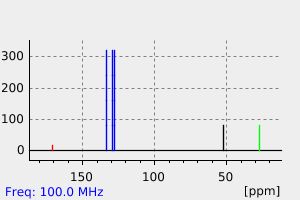methyl (phenylseleno)acetate | 68872-84-4
中文名称
——
中文别名
——
英文名称
methyl (phenylseleno)acetate
英文别名
methyl 2-(phenylseleno)acetate;methyl α-(phenylseleno)acetate;methyl 2-(phenylselanyl)acetate;Methyl 2-phenylselanylacetate
CAS
68872-84-4
化学式
C9H10O2Se
mdl
——
分子量
229.137
InChiKey
CXMJYDPAXINADH-UHFFFAOYSA-N
BEILSTEIN
——
EINECS
——
-
物化性质
-
计算性质
-
ADMET
-
安全信息
-
SDS
-
制备方法与用途
-
上下游信息
-
文献信息
-
表征谱图
-
同类化合物
-
相关功能分类
-
相关结构分类
物化性质
-
沸点:73-74 °C(Press: 0.5 Torr)
计算性质
-
辛醇/水分配系数(LogP):0.61
-
重原子数:12
-
可旋转键数:4
-
环数:1.0
-
sp3杂化的碳原子比例:0.22
-
拓扑面积:26.3
-
氢给体数:0
-
氢受体数:2
反应信息
-
作为反应物:参考文献:名称:基团转移羰基化:伴随苯硒烯基转移的烯烃的光诱导烷基化羰基化。摘要:α-(苯基硒代)乙酸甲酯(1b)和相关化合物在烯烃和CO存在下的光解反应通过基团转移羰基化反应生成酰基硒化物2。这种三组分偶联反应的机理包括向烯烃添加(甲氧基羰基)甲基,通过CO捕获所产生的烷基自由基,以及通过从起始原料转移的苯基硒烯基来终止反应。DOI:10.1021/jo960349y
-
作为产物:描述:二苯基碘三氟甲烷磺酸盐 在 sodium tetrahydroborate 作用下, 以 乙醇 、 乙腈 为溶剂, 反应 24.25h, 生成 methyl (phenylseleno)acetate参考文献:名称:非金属合成不对称有机硒酸酯和硒代糖苷摘要:已经开发了一种一锅无金属的方法来合成不对称的有机硒化物。在反应的第一步中,在不存在金属催化剂的情况下,将硒氰酸钾(KSeCN)与碘鎓试剂进行芳基化以生成芳基硒氰酸酯。在第二步中,用硼氢化钠处理可掩盖与脂肪族亲电子试剂,碘鎓试剂或糖基卤化物结合的第二硒亲核试剂。该方法代表了合成芳基硒化物的一种不安全的方法。DOI:10.1021/acs.orglett.7b02526
文献信息
-
Direct biocatalysed synthesis of first sulfur-, selenium- and tellurium- containing <scp>l</scp>-ascorbyl hybrid derivatives with radical trapping and GPx-like properties作者:Damiano Tanini、Beatrice Lupori、Gianni Malevolti、Moira Ambrosi、Pierandrea Lo Nostro、Antonella CapperucciDOI:10.1039/c9cc02427a日期:——
6-
O -l -Ascorbyl selenoesters, thioesters and telluroesters can be efficiently and directly prepared froml -ascorbic acid and suitable functionalised chalcogenoesters through lipase-catalysed transesterification reactions. -
Synthesis and computer-aided SAR studies for derivatives of phenoxyalkyl-1,3,5-triazine as the new potent ligands for serotonin receptors 5-HT6作者:Wesam Ali、Małgorzata Więcek、Dorota Łażewska、Rafał Kurczab、Magdalena Jastrzębska-Więsek、Grzegorz Satała、Katarzyna Kucwaj-Brysz、Annamaria Lubelska、Monika Głuch-Lutwin、Barbara Mordyl、Agata Siwek、Muhammad Jawad Nasim、Anna Partyka、Sylwia Sudoł、Gniewomir Latacz、Anna Wesołowska、Katarzyna Kieć-Kononowicz、Jadwiga HandzlikDOI:10.1016/j.ejmech.2019.06.022日期:2019.9(Ki = 11 nM). SAR analysis indicated, that an exchange of oxygen to selenium (7 vs. 22), and especially, to sulfur (7 vs. 19) was beneficial to increase both affinity and antagonistic action for 5-HT6R. Surprisingly, an introduction of SO2 caused a drastic decrease of the 5-HT6R affinity, which was explained at a molecular level based on docking studies. All in vivo tested compounds (10, 18 and 21) did not这项研究提供了迄今为止所研究的1,3,5-三嗪衍生物中活性最高的5-HT 6 R药物,并且还确定了世界上第一个含硒的5-HT 6 R配体。这些研究主要针对新型5-HT 6 R试剂(作为铅结构4-(4-甲基哌嗪-1-基)-6-(苯氧甲基)-1)的衍生物进行设计,合成,生物学评估和对接支持的SAR分析, 3,5-三嗪-2-胺(7)。主要的修饰包括引入:(i)苯环上的各种小取代基,(ii)支化的醚连接基,或(iii)用其他硫族元素(S,Se)或磺酰基部分取代醚氧。因此,一系列新化合物(7 – 24)合成,并检查它们的亲和力对5-HT 6 R和选择性,对于5-HT 1A R,5-HT 2A R,5-HT 7 R和多巴胺d 2受体,在放射性配体结合测定。对于代表性的大多数活性化合物,进行了体外功能性生物测定和毒性分析,以及体内抗抑郁样活性。发现2-异丙基-5-甲基苯基衍生物(10)是活性最高的三嗪5-HT
-
Rhodium-Catalyzed Rearrangement of S/Se-Ylides for the Synthesis of Substituted Vinylogous Carbonates作者:Angula Chandra Shekar Reddy、Pazhamalai AnbarasanDOI:10.1021/acs.orglett.9b03852日期:2019.12.20for the synthesis of various sulfur-tethered vinylogous carbonates in good to excellent yields. Important features of the developed reaction include wide functional group tolerance, excellent chemo- and regioselectivity, and efficient rearrangement involving the carbonyl motif. The present reaction also equally works well with α-selenoesters for the synthesis of seleno-containing vinylogous carbonates
-
A DIRECT PHENYLSELENENYLATION OF ALKYL HALIDES, ALKENYL SULFONATES, AND EPOXIDES BY AN ELECTROREDUCTION OF DIPHENYL DISELENIDE作者:Sigeru Torii、Tsutomu Inokuchi、Goro Asanuma、Noboru Sayo、Hideo TanakaDOI:10.1246/cl.1980.867日期:1980.7.5A convenient procedure for phenylselenenylation of alkyl halides, alkenyl sulfonates, and epoxides with phenyl selenide anion was accomplished by electroreduction of diphenyl diselenide in a protic solvent.
-
Discovery of phenylselenoether-hydantoin hybrids as ABCB1 efflux pump modulating agents with cytotoxic and antiproliferative actions in resistant T-lymphoma作者:Wesam Ali、Gabriella Spengler、Annamária Kincses、Márta Nové、Cecilia Battistelli、Gniewomir Latacz、Małgorzata Starek、Monika Dąbrowska、Ewelina Honkisz-Orzechowska、Annalisa Romanelli、Manuela Monica Rasile、Ewa Szymańska、Claus Jacob、Clemens Zwergel、Jadwiga HandzlikDOI:10.1016/j.ejmech.2020.112435日期:2020.8terms of design, synthesis, and biological assays, including an insight into cellular mechanisms of anticancer action as well as an ADMET-screening in vitro were performed, followed by in-depth SAR analysis. Among the investigated new phenylselenoether hybrids, four compounds showed significant cytotoxic and anti-proliferative effects, in particular, in resistant cancer cells. Hydantoin derivatives (5–7)癌细胞中的多药耐药性(MDR)是成功治疗癌症要考虑的关键方面。P-gp / ABCB1是ABC转运蛋白的成员,参与了主要的肿瘤MDR机制,负责药物和细胞毒性物质的外排。在这里,我们描述了一种具有潜在抗癌活性的有效的含硒ABCB1 MDR外排泵调节剂的发现。对三组硒醚进行了设计,合成和生物学分析方面的全面研究,包括深入了解抗癌作用的细胞机制以及体外ADMET筛选进行了深入的SAR分析。在研究的新的苯基硒醚杂化物中,四种化合物表现出显着的细胞毒性和抗增殖作用,特别是在耐药性癌细胞中。乙内酰脲衍生物(5 – 7)比参考抑制剂维拉帕米(在低10倍的浓度下最高可达2.6倍)调节ABCB1外排泵的效果显着,并且还具有良好的药物相互作用曲线。最好的化合物(6在人的JURKAT T淋巴细胞癌细胞中进一步评估了其对细胞增殖速率的影响。从机制上讲,细胞周期增强剂cyclin D1的表达下降,而单独用化合物6或
表征谱图
-
氢谱1HNMR
-
质谱MS
-
碳谱13CNMR
-
红外IR
-
拉曼Raman
-
峰位数据
-
峰位匹配
-
表征信息
同类化合物
(βS)-β-氨基-4-(4-羟基苯氧基)-3,5-二碘苯甲丙醇
(S,S)-邻甲苯基-DIPAMP
(S)-(-)-7'-〔4(S)-(苄基)恶唑-2-基]-7-二(3,5-二-叔丁基苯基)膦基-2,2',3,3'-四氢-1,1-螺二氢茚
(S)-盐酸沙丁胺醇
(S)-3-(叔丁基)-4-(2,6-二甲氧基苯基)-2,3-二氢苯并[d][1,3]氧磷杂环戊二烯
(S)-2,2'-双[双(3,5-三氟甲基苯基)膦基]-4,4',6,6'-四甲氧基联苯
(S)-1-[3,5-双(三氟甲基)苯基]-3-[1-(二甲基氨基)-3-甲基丁烷-2-基]硫脲
(R)富马酸托特罗定
(R)-(-)-盐酸尼古地平
(R)-(-)-4,12-双(二苯基膦基)[2.2]对环芳烷(1,5环辛二烯)铑(I)四氟硼酸盐
(R)-(+)-7-双(3,5-二叔丁基苯基)膦基7''-[((6-甲基吡啶-2-基甲基)氨基]-2,2'',3,3''-四氢-1,1''-螺双茚满
(R)-(+)-7-双(3,5-二叔丁基苯基)膦基7''-[(4-叔丁基吡啶-2-基甲基)氨基]-2,2'',3,3''-四氢-1,1''-螺双茚满
(R)-(+)-7-双(3,5-二叔丁基苯基)膦基7''-[(3-甲基吡啶-2-基甲基)氨基]-2,2'',3,3''-四氢-1,1''-螺双茚满
(R)-(+)-4,7-双(3,5-二-叔丁基苯基)膦基-7“-[(吡啶-2-基甲基)氨基]-2,2”,3,3'-四氢1,1'-螺二茚满
(R)-3-(叔丁基)-4-(2,6-二苯氧基苯基)-2,3-二氢苯并[d][1,3]氧杂磷杂环戊烯
(R)-2-[((二苯基膦基)甲基]吡咯烷
(R)-1-[3,5-双(三氟甲基)苯基]-3-[1-(二甲基氨基)-3-甲基丁烷-2-基]硫脲
(N-(4-甲氧基苯基)-N-甲基-3-(1-哌啶基)丙-2-烯酰胺)
(5-溴-2-羟基苯基)-4-氯苯甲酮
(5-溴-2-氯苯基)(4-羟基苯基)甲酮
(5-氧代-3-苯基-2,5-二氢-1,2,3,4-oxatriazol-3-鎓)
(4S,5R)-4-甲基-5-苯基-1,2,3-氧代噻唑烷-2,2-二氧化物-3-羧酸叔丁酯
(4S,4''S)-2,2''-亚环戊基双[4,5-二氢-4-(苯甲基)恶唑]
(4-溴苯基)-[2-氟-4-[6-[甲基(丙-2-烯基)氨基]己氧基]苯基]甲酮
(4-丁氧基苯甲基)三苯基溴化磷
(3aR,8aR)-(-)-4,4,8,8-四(3,5-二甲基苯基)四氢-2,2-二甲基-6-苯基-1,3-二氧戊环[4,5-e]二恶唑磷
(3aR,6aS)-5-氧代六氢环戊基[c]吡咯-2(1H)-羧酸酯
(2Z)-3-[[(4-氯苯基)氨基]-2-氰基丙烯酸乙酯
(2S,3S,5S)-5-(叔丁氧基甲酰氨基)-2-(N-5-噻唑基-甲氧羰基)氨基-1,6-二苯基-3-羟基己烷
(2S,2''S,3S,3''S)-3,3''-二叔丁基-4,4''-双(2,6-二甲氧基苯基)-2,2'',3,3''-四氢-2,2''-联苯并[d][1,3]氧杂磷杂戊环
(2S)-(-)-2-{[[[[3,5-双(氟代甲基)苯基]氨基]硫代甲基]氨基}-N-(二苯基甲基)-N,3,3-三甲基丁酰胺
(2S)-2-[[[[[((1S,2S)-2-氨基环己基]氨基]硫代甲基]氨基]-N-(二苯甲基)-N,3,3-三甲基丁酰胺
(2S)-2-[[[[[[((1R,2R)-2-氨基环己基]氨基]硫代甲基]氨基]-N-(二苯甲基)-N,3,3-三甲基丁酰胺
(2-硝基苯基)磷酸三酰胺
(2,6-二氯苯基)乙酰氯
(2,3-二甲氧基-5-甲基苯基)硼酸
(1S,2S,3S,5S)-5-叠氮基-3-(苯基甲氧基)-2-[(苯基甲氧基)甲基]环戊醇
(1S,2S,3R,5R)-2-(苄氧基)甲基-6-氧杂双环[3.1.0]己-3-醇
(1-(4-氟苯基)环丙基)甲胺盐酸盐
(1-(3-溴苯基)环丁基)甲胺盐酸盐
(1-(2-氯苯基)环丁基)甲胺盐酸盐
(1-(2-氟苯基)环丙基)甲胺盐酸盐
(1-(2,6-二氟苯基)环丙基)甲胺盐酸盐
(-)-去甲基西布曲明
龙蒿油
龙胆酸钠
龙胆酸叔丁酯
龙胆酸
龙胆紫-d6
龙胆紫







